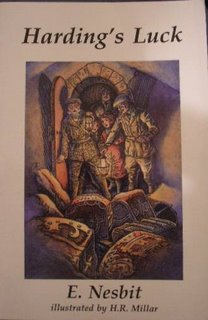
Harding's Luck. Edith Nesbit
Are Edith Nesbit's novels where J. K. Rowling got the idea for her Harry Potter series in which magical witches and wizards live secretly among normal humdrum people (muggles)? It was Nesbit, who wrote 60 children's novels, that first started writing about everyday English children discovering magical people, charms, and spells in their midst. One of the founding members of the Fabian Society, Nesbit was famous in her time for her Socialist beliefs and friends. However, presently it is her children's books that are her enduring legacy.
Harding's Luck is the second of a pair of novels about Dickie Harding a young orphan in 1906 London who uses a crutch because his left leg doesn't work. When his father died he left Dickie an old toy that was to bring him luck, but as the story opens there is little luck or joy in the child's life.
Nesbit's Socialist beliefs are strongly represented in her portrayal of Dickie's poverty. She describes life for the poor of the time as follows. "...All the green trees are gone, and good work is gone, and people do bad work for just so much as will keep together their worn bodies and desolate souls. And sometimes they starve to death." She also portrays a society strictly divided by class in which Dickie is poor but has noble blood which elevates him above those around him.
The magic of the story is a spell involving the toy his father gave him that puts him in contact with a trio of magical moles called Mouldiwarps and a nursemaid witch. This group transport him back 300 years to the time of King James I where he is Richard Arden, a young boy of noble family who has two healthy legs. He travels back and forth between his London and that of James I with the help of the Mouldiwarps. In the process he saves the Arden family's fortune and has to decide between his present-day London and that of 300 years ago.
Nesbit is a wonderful storyteller and the plot is full of detail and adventure that make it a delight to read. Her use of the street language of the time makes this a difficult book for young readers of today, but adults who like children's literature will find it a delightful glimpse of English life. H. R. Millar's 16 original drawings help bring the tale to life. This Books of Wonder edition suffers from bad proofreading. I found over a dozen misspellings that should have been caught in the editing process. Although this is one of a two volume series, it can be read alone with no problem.
No comments:
Post a Comment